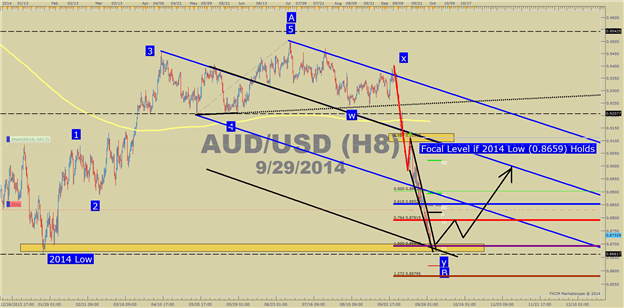Where to Place Stops When Using Elliott Wave
Post on: 14 Октябрь, 2015 No Comment

Talking Points:
-Elliott Wave Overview
-Placing Stops with Elliott Wave
-Example with AUDUSD
The Wave Principle is a simple rule-based methodology (3 rules) that allows the practitioner to dissect the collective mindset of the markets participants, which allows for defined, attractive/positive risk-reward trading/investing parameters—A game plan.
—Andrew Baptiste, Chief Technical Analyst, Morgan Stanley (1999-2011)
One thing you can almost always count on with Elliott Wave is that it is a controversial subject when brought up in a room of traders. One side argues that human nature and mental biases are much too abstract to move how Elliott Wave Theory says they often move. The other side argues that the beauty of Elliott Wave Theory is that within all the different news prints, sentiment indicators, and headlines, there is a limit to optimism and pessimism regardless of the environment and Elliott Wave is an effective frame work from which a trader can build an outlook to trade while managing risk.
Elliott Wave Overview
In its simplest form, Elliott Wave is a trend trading timing tool. Elliott Wave is a trend trading tool in that it is built off of the concept that markets move in an uptrend with a set of higher lows and higher highs during times of optimism and conversely, markets can move with a set of lower highs and lower lows in times of pessimism. Elliott Wave is a time tool because it can help you identify common areas where a counter trend move is exhausted before the trend resumes. In the end, its a probability game so its critical that you trade with a favorable risk-reward ratio and that you are able to recognize common trend-correction patterns.
How to Plac e Stops with Elliott Wave
Revisiting the prior argument, there are often intense views of Elliott Wave. However, if you keep an Elliott Wave count of the market to put the current move in context, you should have a point of invalidation or a price at which your view would be invalidated should the market trade there. That level of invalidation can and should act as your stop placement.
If you’re still in a trade when your wave count is invalidated, you’re like a fish out of water.
Taking this further, if you keep track of the 3 Cardinal Rules of Elliott Wave, you can use them to place a stop on the market your trading
3 Cardinal Rules of Elliott Wave
- Wave two can never retrace more than 100% of wave one. Wave four may never end in the price territory of wave one. Wave three may never be the shortest impulse wave of waves one, three and five.
These simple three rules can allow you to stay objective to your view of the market. If your view of the market doesnt break any of the three cardinal rules above, then you have a valid count and likely understand the context of the market.
As a trader, if youre outlook is wrong as identified by the market breaking any of the above rules, then youre a fish out of water and likely shouldnt have your money at further risk because what you thought was, wasnt in fact.
Following this schematic, if you believe youre trading wave 3, the strongest and best trade to be in, then you should have your stop under what you perceive to be W.1. If you believe youre in a W.5 and youre looking to follow the trend and buy W.5 in the uptrend, you want to be sure youre not still in W.4 or a different move that is reversing so you can put your stop at the end of W.1.
Of course, you want to be trading in the direction of the trend. In the end, if a level you identify as a reversal point is penetrated, then you should be out of the market. This can keep you objective and focused on only trading and staying in healthy trends.
Example with AUDUSD

Presented by FXCMs Marketscope Charts
This example of AUDUSD shows a 5-wave move higher followed by a potential, yet to be confirmed, 3-wave correction. If this holds, the 2014 low could still be the beginning of a new trend higher and when your conviction allows, you could buy AUDUSD with a stop below that level. Therefore, if you enter a trade because you believe a new trend is higher, you can use either the beginning of Wave 1 or the end of Wave 1 as a stop because when either of those levels give way, it is a sign that the trend integrity is weakening.
Now that you know a common pre-trend move, feel free to test your knowledge out on a free FXCM UK Demo account.
Happy Trading!
—Written by Tyler Yell, Trading Instructor
To contact Tyler, email tyell@dailyfx.com
To be added to Tyler’s e-mail distribution list, please click here
Tyler is available on Twitter @ ForexYell
Become a Smarter Trader Today
Claim your FREE universal membership to DailyFX Internet Courses & save yourself hours in figuring out what FOREX trading is all about.
You’ll get this FREE 20 minute New to FX course presented by DailyFX Education. In the course, you will learn about the basics of a FOREX transaction, what leverage is, and how to determine an appropriate amount of leverage for your trading.
DailyFX provides forex news and technical analysis on the trends that influence the global currency markets.
Learn forex trading with a free practice account and trading charts from FXCM.














